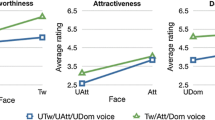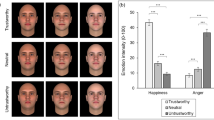Abstract
The facial appearance of television spokespersons and the trustworthiness and expertise of the appeals delivered by them were independently rated. Babyfaced persons and females delivered communications which were less expert, but more trustworthy, than those communications delivered by maturefaced persons and males. These effects were independent of the spokespersons' perceived age, attractiveness, and amount of smiling. The findings are consistent with past research which has demonstrated that babyfaced people are perceived as less knowledgeable, but more honest, than those who are maturefaced.
Similar content being viewed by others
References
Atkins, C., & Block, M. (1983). Effectiveness of celebrity endorsers.Journal of Advertising Research, 23, 57–61.
Berry, D. S., & Brownlow, S. (1989) Were the physiognomists right? Personality correlates of facial babyishness.Personality and Social Psychology Bulletin, 15, 266–279.
Berry, D. S., & McArthur, L. Z. (1985). Some components and consequences of a babyface.Journal of Personality and Social Psychology, 48, 312–323.
Berry, D. S., & McArthur, L. Z. (1986). Perceiving character in faces: The impact of age-related craniofacial changes on social perception.Psychological Bulletin, 100, 1–16.
Berry, D. S., & Zebrowitz-McArthur, L. (1988). (1988). What's in a face? Facial maturity and the attribution of legal responsibility.Personality and Social Psychology Bulletin, 14, 22–33.
Brownlow, S. (1989).The interactive effects of facial appearance and credibility information on attitude change. Unpublished doctoral disseration, Brandeis University.
Deaux, K. (1985). Sex and gender.Annual Review of Psychology, 36, 49–81.
Friedman, H. H., & Friedman, L. (1979) Endorser effectiveness by product type.Journal of Advertising Research, 23, 57–61.
Hovland, C. I., Janis, I. L., & Kelley, H. H. (1953).Communication and persuasion. New Haven, CT: Yale University Press.
Keating, C. F. (1985). Gender and the physiognomy of dominance and attractiveness.Social Psychology Quarterly, 48, 61–70.
Keating, C. F., & Bai, D. L. (1986). Children's attributions of social dominance from facial cues.Child Development, 57, 1269–1276.
Keating, C. F., Mazur, A., & Segall, M. H. (1981). A cross-cultural exploration of physiognomic traits of dominance and happiness.Ethology and Sociobiology, 2, 41–38.
McArthur, L. Z., & Apatow, K. (1983–1984). Impressions of babyfaced adults.Social Cognition, 2, 315–342.
McArthur, L. Z., & Berry, D. S. (1987). Cross-cultural agreement in perceptions of babyfaced adults.Journal of Cross-Cultural Psychology, 18, 165–192.
McArthur, L. Z., & Resko, B. G. (1975). The portrayal of men and women in American television commercials.Journal of Social Psychology, 97, 209–219.
McGuire, W. J. (1969). The nature of attitudes and attitude change. In G. Lindzey & E. Aronson (Eds.),The handbook of social psychology, Vol. 3 (pp. 136–314). Reading, MA: Addison-Wesley.
McGuire, W. J. (1973). The yin and yang of progress in social psychology: Seven koan.Journal of Personality and Social Psychology, 26, 446–456.
McGuire, W. J. (1985). Attitudes and attitude change. In G. Lindzey & E. Aronson (Eds.),The handbook of social psychology, Vol. 2 (pp. 233–346). Hillsdale, NJ: Lawrence Erlbaum Associates.
Montepare, J. M., & Zebrowitz-McArthur, L. (1989). Children's perceptions of adults with babyfaces.Perceptual and Motor Skills, 69, 467–472.
Schmitt, B. H. (1987) The ecological approach to social perception: A conceptual critique.Journal for the Theory of Social Behavior, 17, 261–278.
Zebrowitz, L. A., & Montepare, J. M. (1990).Impressions of babyfaced and maturefaced individuals across the lifespan. Unpublished manuscript, Brandeis University.
Zebrowitz, L. A., Tennenbaum, D., & Goldstein, L. (1990).The impact of job applicants' facial maturity, sex, and academic achievement on hiring recommendations. Unpublished manusucript, Brandeis University.
Author information
Authors and Affiliations
Additional information
The authors are grateful to Mike Berbaum, Diane Berry, and two anonymous reviewers for helpful comments on an earlier draft. Portions of this research were presented at the 59th Annual Meeting of the Eastern Psychological Association in April, 1988, in Buffalo, N.Y.
Rights and permissions
About this article
Cite this article
Brownlow, S., Zebrowitz, L.A. Facial appearance, gender, and credibility in television commercials. J Nonverbal Behav 14, 51–60 (1990). https://doi.org/10.1007/BF01006579
Issue Date:
DOI: https://doi.org/10.1007/BF01006579




